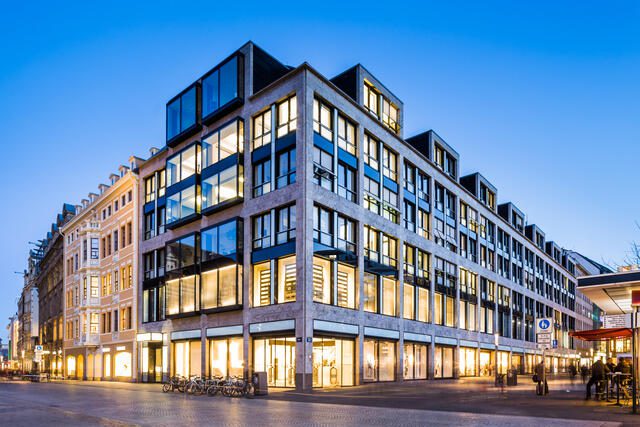
If you own or operate commercial real estate, this blog series might be one of the most important things you read in the upcoming months. You’ll understand why ‘all-electric, all-digital’ properties will play a crucial part in your business success, provide an understanding of what these terms mean, and how they can positively impact your buildings, operations, tenants, and bottom line.
Schneider Electric’s vision for Buildings of the Future is particularly relevant for today’s commercial real estate market. Its leaders will have portfolios that fully embrace sustainability, hyper-efficiency, resiliency, and people-centricity. By the electrification and digitalization of properties, today’s real estate investors, owners, and operators can achieve these ambitions and future-proof their facilities.
So, what is today’s commercial real estate market asking for, and what kinds of electric and digital upgrades should you consider?
A brand new world for commercial real estate
Current commercial real estate market challenges are unique and unprecedented, and ‘all bets are off’ in predicting how things will evolve. Still, it will undoubtedly include the need to attract back tenants, minimize operation costs, and meet sustainability goals while complying with regulations. This will cause some introspection within organizations as they try to determine what tools are required to succeed under the post-COVID ‘new normal.’
In this context, I will assume that your building’s electricity supply has been a relatively minor concern. If the building designers made sure it complied with electrical codes, then that was enough. And the energy bills might not represent a large percentage of operation costs, so you pay them. As long as the building is operating, you may find that there is nothing to worry about.
However, when you start to think of how electricity affects almost every aspect of building and tenant operations, you can begin to appreciate its actual value. That value and how you manage it continues to increase, and building codes are not changing fast enough to keep up with market needs.
In 2030, you may have a building up to code, but it might be completely unleasable and unsellable. It’s not that the code is no longer necessary; it’s that you need to stay ahead of the curve to anticipate future needs. Here are three trends to consider.
1. We’re no longer burning “things” in buildings
When we say it will be an “all-electric future,” what do we mean? Simply put, we will stop burning things, and there are many “things” driving this inevitability.
A New York Intelligencer article noted, “the age of climate denial is over, thanks to extreme weather and the march of science and the historic labor of activists … The cultural cachet of oil companies is quickly approaching that of tobacco companies … Practically every leader of every country and every major figure in every corporate and industrial sector now feels obligated — because of protest and social pressure, economic realities, and cultural expectation — to at least make a show of support for climate action.”
While addressing the European Commission’s proposal to make the E.U. achieve net-zero emissions by 2050, a McKinsey report confidently states, “Most of the technology required to decarbonize the buildings sector is already available.” However, to meet the goal, “Gas usage in buildings would also need to fall by more than half.”
Driven by governmental mandates and corporate sustainability goals, CRE buildings are encouraged on a path towards 100% electrification. We get many calls from real estate investors and investment trusts asking how to upgrade their portfolios to be greener, more sustainable, and ready for this new future.
We often recommend:
- Choosing – or converting to – electric boilers instead of gas.
- Moving to heat pumps.
- Adding on-site renewable energy generation and storage to reduce grid energy consumption.
But how can these upgrades be cost-effective and provide an ROI?
The capital could come from the many organizations and funds seeking greener investments in companies demonstrating sustainable practices.
Richard Kelly with Legal & General Investment Management stated, “Environmental, social and governance [ESG] investing is now coming to the fore … Millennials in particular want to see their investments have a low carbon footprint … People are saying they don’t want fossil fuels, they want renewable energy instead.” In fact, futurist Jeremy Rifkin predicts the future for the fossil fuel industry is bleak, saying, “Citigroup, a big bank, says this could be some $100 trillion in stranded assets across the fossil fuel civilization. The Economist magazine’s Intelligence Unit said it’s at least $40 trillion.”
2. Supporting the explosive growth of electric vehicles
To reduce U.S. greenhouse gas emissions by 50% by 2030, President Biden recently signed an executive order targeting half of all new cars sold in the U.S. to be electric by 2030 (currently, it is only about 2%). The ICCT reported in 2020 on the E.V. goals announced by other major countries. For example, Canada and Singapore commit to being all E.V.s by 2040, France to all passenger and light-duty commercial E.V.s by 2040, Germany to all passenger E.V.s by 2050, Denmark to all passenger EVs by 2035, and U.K. to all passenger and van E.V.s by 2035.
What will the impact of these commitments be on the built environment?
Think about this: roughly 90% of people’s lives are spent indoors. That is when they want their E.V. to be charging. Every building in the world, whether a residence, office, mall, or hospital, will take on the extra role of a vehicle charging station. Some cities in the U.S. are already mandating that 25 or 30 percent of new parking garages and surface lots need to be E.V. changing capable or ready.
McKinsey estimates “as many as 130 million E.V.s could be sharing roads the world over by 2030 … on-site commercial charging will need to become a standard building feature in the next ten years to meet consumer demand.” For existing buildings, this means the need to upgrade. “E.V. charging at scale requires careful planning of a building’s electrical distribution system as well as local electric-grid infrastructure.”
This kind of infrastructure expansion will require planning permission and, possibly, consultation with the local utility. It will also require selecting the safest and most optimal charging solutions, engineering construction, and installation, and, of course, needs to have enough capacity.
Luckily, today’s technology enables this upgrade to easily retrofit within a building’s electrical switchgear and be scalable if required. You will also need the digital infrastructure to manage it, with the analytics to balance charging requirements against maintaining building comfort and resilience.
Serving E.V. owners and fleet charging needs will be a massive opportunity for CRE professionals to enhance the value of their properties and use the convenience of on-site charging as a differentiator to attract the most desirable tenants. By starting now, you will be anticipating E.V. charging regulations that are likely to be coming for more regions around the globe.
3. Digitalization supercharges power and building management
The term ‘smart buildings’ has been used a lot in recent years, but what does it actually mean? It simply means having the intelligent tools needed to make your buildings more sustainable, efficient, resilient, and people-centric. Beyond electrification, the digital transformation of your buildings will help you achieve important operational and business outcomes.
Digitalizing power and building management will bring data from connected devices across your facility to the apps and cloud-based services that turn it into the visibility and insights that you and your tenants need to make decisions and take action, sometimes automatically. Your facility management team will get a unified view of every aspect of building performance, from energy efficiency to power reliability, comfort, and air quality. They can access data and systems remotely while sharing and collaborating across teams and with expert services.
So what can you do with all of this information? Here are just a few examples that we will expand on in the following posts:
- Digital enables condition-based maintenance. Access to real-time information on the health of your building systems will help you transition from a reactive to a preventative maintenance approach, saving up to 20% in costs while extending lifespan and improving reliability.
- Digital improves efficiency and sustainability. Studies have shown that half of the economic potential of energy savings has already been harvested for industrial buildings. It is only 18 % for commercial buildings, so it is still untapped 82 % of the economic potential. Digitalization helps you uncover energy waste and inefficiencies, unleashing continuous savings that you can reinvest to fund more projects that remove more carbon from your operations.
- Digital helps optimize financial performance. Managing multiple buildings across global geographies makes it challenging to evaluate how green each asset really is. Digitalized power and building management will help you:
- Validate if each building is performing to spec.
- Compare performance across buildings
- Normalized for differences in weather, occupancy, bank holidays, etc., to filter out the ‘noise.’
- Determine which buildings are doing better and which energy manager is doing a better job so that you can leverage best practices.
- Use real-time reporting to demonstrate exceptional performance, helping you get better access to capital or lower interest rates, and allowing you to go and do more business.
- Digital makes your buildings more resilient. Real-time monitoring helps detect equipment risks and maximize uptime to allow your facility team to quickly respond to, isolate, and resolve problems. Resiliency also means adapting to market conditions, and your building’s infrastructure needs to be flexible enough to meet tenant needs under the ‘new normal.’ Digitalization will support a hybrid office-home working model that requires reconfiguring space to suit new uses and more dynamic situations.
- Digital supports healthier, more engaging occupant experiences. Connected building solutions help you monitor indoor air quality, people flow, and occupancy levels, which can be used to automate ventilation and help facility personnel manage safety protocols. The newest employee apps can be used for wayfinding, room booking, and hands-free control over room comfort. You will also understand how people are using the app and your building, and sharing these insights make for a closer working relationship between the head of real estate and clients.
Sustainable Commercial Buildings in South Florida
Are you looking for energy conservation and digitalization solutions for your commercial building? Advanced Control Corporation is here to help! Advanced Control Corporation has been a leader in energy conservation in South Florida for over twenty years. Contact us today to at 954-491-6660 to get started on implementing energy conservation solutions for your building!
Published with permission from Schneider Electric.


